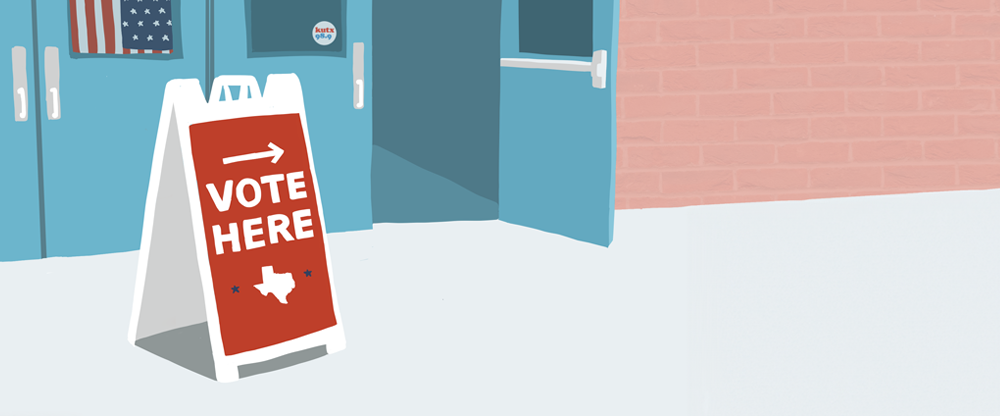Election Day is Tuesday, November 5 (7 A.M. to 7 P.M.)
Voters have been thinking about the presidential election for months. Local races down the ballot don’t usually get as many eyes. But state and local races (like this one) are important, too! In the Austin area, major positions like Austin mayor and Travis County district attorney, plus multimillion-dollar funding proposals for schools and child care, are up for a vote.
If you care about the cost of housing in your neighborhood, the way that roads are built and changed, or how much money teachers get paid — these local races are where you can make a difference.
Here’s what you need to know.
What’s on the ballot?
You can’t use a cell phone at the polls, so you’ll want to read up on races ahead of time and, if needed, write your picks on a piece of paper. To help you prepare, our sister-station KUT 90.5 has put together voter guides for three counties. Each guide has information on the biggest races in the area, plus links to sample ballots:
Want to see your personalized sample ballot? Type in your address below or click this link.
Am I registered to vote?
You can go to the Texas Secretary of State’s website to check your registration anywhere in the state. If it turns out you’re not registered, the deadline for this election has passed — but you can visit the Vote Texas site to learn how to register for future elections.
When and where can I vote?
On Election Day, you have to vote at a polling location in the county where you live. Within your county, you can vote at any Vote Center where the “Vote Here/Aqui” sign is displayed. Polls will be open from 7 a.m. until 7 p.m. IMPORTANT: If you are in line when polls close at 7 p.m., be sure to stay in line – you will be allowed to vote!
Click here for a downloadable list of Travis County voting locations. You can also check live wait times on the Travis County website.
Find Williamson County voting locations on the county’s website.
Find Hays County voting locations on the county’s website.
What do I bring with me to the polls?
Make sure to bring a photo ID when you vote. Acceptable forms of ID include:
- Texas driver’s license
- Texas election identification certificate
- Texas personal identification card
- Texas handgun license
- U.S. military identification card that includes your photograph
- U.S. citizenship certificate that includes your photograph
- U.S. passport
The ID can be expired for up to four years. If you’re 70 or older, you can bring a photo ID that has been expired for any length of time.
If you had trouble getting an ID, here are the alternatives you can bring to the polls:
- government document showing your name and an address, such as your voter registration certificate
- current utility bill
- bank statement
- government check
- paycheck
- certified birth certificate or court admissible birth document
All of these documents can either be a copy or the original. If you use one of these, you’ll have to sign a form that says you had a reasonable impediment to getting an ID.
If you are between the age of 18 and 69, you can use an acceptable form of ID, even if it is expired, as long as it hasn’t been expired for more than 4 years before the date you present it at the polling place. The only exception is the U.S. Citizenship Certificate, which does not expire. If you are 70 or older, your acceptable form of photo identification may be expired for any length of time if the identification is otherwise valid.
Find more detailed information about Voter ID Requirements
What not to do at the polls
Remember that you can’t use cellphones, cameras, computers or any kind of recording device within 100 feet of voting booths. If you were planning to have some notes on your phone, print them out instead.
You also can’t wear clothes or accessories relating to a candidate, political party or measure on the ballot.
Voting by mail?
In Texas, you can vote by mail only if you:
- won’t be in the county you’re registered in during early voting and on Election Day
- are sick or disabled
- are expecting to give birth within three weeks before or after Election Day
- are 65 or older on Election Day
- are in prison or civil commitment, but are otherwise eligible
To vote by mail, print the “Application for Ballot by Mail” or submit an online request for it to be mailed to you. Fill out the required sections and sign your name with the date, then mail the completed application to the early voting clerk in your county. You can visit the Texas Secretary of State’s website for more guidance.
The deadline to submit a request for a mail-in ballot is Oct. 25. To vote by mail, print the “Application for Ballot by Mail” or submit an online request for it to be mailed to you. Fill out the required sections and sign your name with the date, then mail the completed application to the early voting clerk in your county. You can visit the Texas Secretary of State’s website for more guidance.
The Austin-area League of Women Voters has also put together a guide to voting by mail for Central Texas voters, which you can find on the organization’s website.
Once you get your mail-in ballot, there are some extra deadlines you should keep in mind to make sure your ballot is received on time:
- Postmarked: Nov. 5 by 7 p.m.
- Post received: Nov. 6 by 5 p.m.
- In-person received: Nov. 5 by 7 p.m.
Once you’ve returned your mail-in ballot, you can check its status on the Texas Secretary of State’s website.
If you received a ballot by mail but prefer to vote in person, you must surrender your mail ballot at the polling place.
Check out these additional voting resources
Find more information about Voting in Texas at VoteTexas.gov
Need assistance at the polls, or need to report an issue with you polling place? Election Protection is a non-partisan group that stations their volunteers outside many polling places. If there is no volunteer onsite, call them at 866-OUR-VOTE or visit their website.
Want to help on Election Day? Election Protection is seeking volunteers to monitor social media for election disinformation and voting issues on Election Day. You can train and volunteer from home. Take their self-guided training here.







